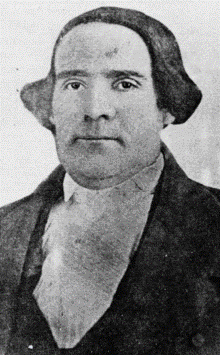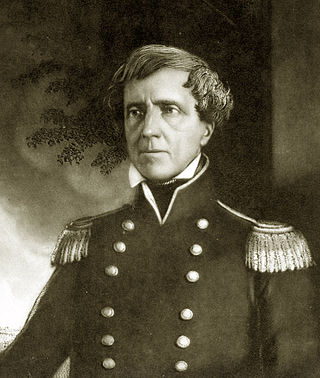
Stephen Watts Kearny was one of the foremost antebellum frontier officers of the United States Army. He is remembered for his significant contributions in the Mexican–American War, especially the conquest of California. The Kearny code, proclaimed on September 22, 1846, in Santa Fe, established the law and government of the newly acquired territory of New Mexico and was named after him. His nephew was Major General Philip Kearny of American Civil War fame.

Charles Bent was an American businessman and politician who served as the first civilian United States governor of the New Mexico Territory, newly acquired by the Military Governor, Stephen Watts Kearny, in September 1846.
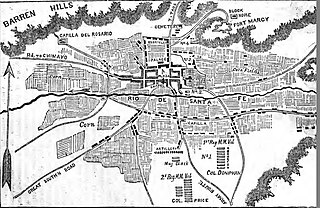
The Capture of Santa Fe, also known as the Battle of Santa Fe or the Battle of Cañoncito, took place near Santa Fe, New Mexico, the capital of the Mexican Province of New Mexico, during the Mexican–American War on 8 August through 14 August 1846. No shots were fired during the capturing of Santa Fe.

The Taos Revolt was a populist insurrection in January 1847 by Hispano and Pueblo allies against the United States' occupation of present-day northern New Mexico during the Mexican–American War. Provisional governor Charles Bent and several other Americans were killed by the rebels. In two short campaigns, United States troops and militia crushed the rebellion of the Hispano and Pueblo people. The New Mexicans, seeking better representation, regrouped and fought three more engagements, but after being defeated, they abandoned open warfare. Hatred of New Mexicans for the occupying American army combined with the oft-exercised rebelliousness of Taos residents against authority imposed on them from elsewhere were causes of the revolt. In the aftermath of the revolt the Americans executed at least 28 rebels. The Treaty of Guadalupe Hidalgo in 1850 guaranteed the property rights of New Mexico's Hispanic and American Indian residents.

Antonio José Martínez was a New Mexican priest, educator, publisher, rancher, farmer, community leader, and politician. He lived through and influenced three distinct periods of New Mexico's history: the Spanish period, the Mexican period, and the American occupation and subsequent territorial period. Martínez appears as a character in Willa Cather's novel, Death Comes for the Archbishop.
The Río Arriba Rebellion, also known as the Chimayó Rebellion, was an 1837 Pueblo-Hispano popular revolt in New Mexico which succeeded in briefly placing José María González and Pablo Montoya as governor of Mexico's Santa Fe de Nuevo México territory. González and Montoya were both Taos Pueblo Indians and led the independent Junta Popular or Cantón, which was the most ethnically inclusive government in the history of New Mexico. They remain the only Pueblo governors of New Mexico to this day.
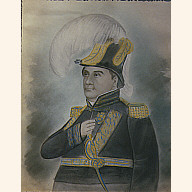
Manuel Armijo was a New Mexican soldier and statesman who served three times as governor of New Mexico. He was instrumental in putting down the Revolt of 1837, he led the force that captured the Texan Santa Fe Expedition, and he later surrendered to the United States in the Mexican–American War, leading to the Capture of Santa Fe.
Guadalupe Miranda was a Mexican public official who was mayor of Ciudad Juárez and recipient of the 1,700,000-acre (6,900 km2) Beaubien-Miranda Land Grant.

Brigadier General Diego Archuleta, was a member of the Mexican Congress. He joined the Mexican Army to fight against the United States in the Mexican–American War. Later, he was appointed an Indian Agent by President Abraham Lincoln, and joined the Union Army during the American Civil War. Archuleta became the first Hispanic to reach the military rank of Brigadier General.
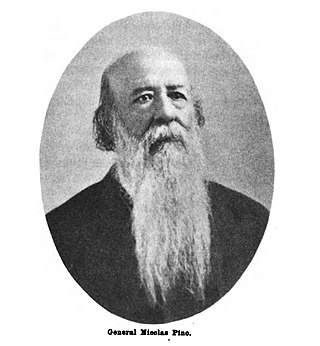
Nicolas Pino (1819–1896) was a Mexican loyalist, civil and military leader who participated in planned resistance and rebellion against the U.S. occupation of New Mexico. Following the Treaty of Guadalupe Hidalgo, he swore allegiance to the United States and became a Union officer during American Civil War, rising to the rank of brigadier general on September 9, 1861. He later served in the New Mexico Territorial legislature.

Ramón Ortiz y Miera was a Mexican priest who helped organize armed resistance during the Mexican–American War of 1846 to 1848, and who was frustrated by the U.S. authorities in his efforts to repatriate Hispanic residents from New Mexico to the republic of Mexico after the war.

John MacRae Washington was a United States artillery officer who became military governor of New Mexico shortly after the end of the Mexican–American War of 1846–1848.
Manuel Álvarez was a Spanish-born Santa Fe trader who became lieutenant-governor of New Mexico.
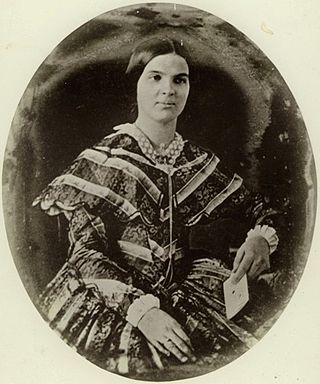
Susan Shelby Magoffin was the wife of a trader from the United States who traveled on the Santa Fe Trail in the late 1840s. The diary in which she recorded her experiences has been used extensively as a source for histories of the time.
Juan Bautista Vigil y Alarid (1792–1866) was acting Governor of New Mexico in 1846 during the period when the United States consolidated military rule over the former territory of Mexico following the Mexican–American War. As such, Alarid was the last Mexican governor of New Mexico.
José Antonio Cháves was géfe político or Governor of the territory of Santa Fe de Nuevo México from September 1829 until 1832.
Francisco Sarracino was the géfe político or governor of New Mexico from 1833 to 1835.
José Mariano Chaves y Castillo was a wealthy Spanish-American landowner who was the acting governor of New Mexico for a few months during 1844. Chaves County, New Mexico is named after him.
José Chavéz y Castillo was a Mexican landowner and trader who served as provisional Governor of New Mexico from 1 May 1845 until 16 November 1845, when Manuel Armijo became governor for a third term.

The San Miguel del Vado Land Grant is one of the Spanish land grants in New Mexico. On November 24, 1794, 53 men submitted a petition for land and were granted temporary possession on November 24, 1794, pending satisfaction of prescribed criteria. A second grant was obtained by 58 men and their respective families on March 12, 1803. Two days later, the procedure was repeated at San José del Vado, 6 kilometres (3.7 mi) north of San Miguel del Vado, distributing farm land to an additional 47 heads of household, including two women.
